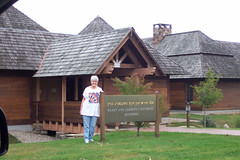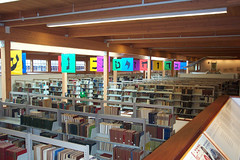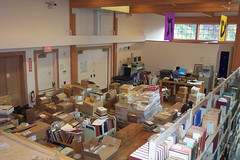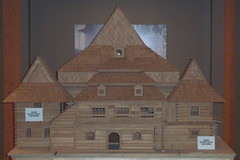Calling All Bibliophiles
One of the reasons that I enjoy visiting my daughter is that she and her husband always have fascinating books laying around. I hasten to add, however, as a dedicated Mormor, my most pressing reason to visit Anna and Aage is to see my precious grandson. Anyway, a while back Anna mentioned that Aage had found a new book for her in Border’s that she thought I’d like.
Was she ever right. If you love books and have never read “Outwitting History,” by Aaron Lansky, do yourself a favor and get a copy. It’s subtitled “The Amazing Adventures of a Man Who Rescued a Million Yiddish Books,” and is the story of how Lansky, along with friends, started a worldwide effort to save Yiddish books and, as a consequence, prevented the demise of Yiddish language. He’s an entertaining writer with a worthy cause.
While we were out East several weeks ago, we managed to cram in a visit to the National Yiddish Book Center, which is situated on the edge of Hampshire College in Amherst, Massachusetts. (This was right before all of the flooding, so I’m worried as to the current state of the Book Center.) The place is just as fascinating as is Mr. Lansky’s book. As the name implies, it’s a museum about Yiddish, but it’s so much more, as it tells the story of how Yiddish evolved and why it’s so important to preserve the large body of works that at one time were thought to have been discarded.
I’m currently on a campaign to entice CBS Sunday Morning to do a feature on it and to also bring Mr. Lansky to Champaign-Urbana to tell his story. At the Center, I noted several local connections: The University of Illinois Library has been one of the recipients of Yiddish books from the Center and the local Yiddish Club of Champaign-Urbana contributed funds for its establishment.
In planning the building for the Book Center, which was to become home to original texts and/or copies of all extant Yiddish literature, the idea was to evoke the image of an Eastern European Synagogue, none of which survived World War II. Most people agree that the goal was beautifully achieved, as evidenced above.
The spaces inside are just as charming. The entryway feels like a friendly foyer; the lighting is soft, the walls are framed in bare wood, the exhibits beckoning. It was a difficult decision as to which way to head first. Overhead, instead of Muzac, one is entertained by Klezmer tunes. For a change, there is no charge for admission and one is welcome to take pictures, so we took advantage of that freedom.
If you choose to walk directly ahead, you realize that you’re actually on a balcony, looking down to the collection of Yiddish books that are available for purchase.
From that vantage point you can also see the receiving area, with stacks of assorted half opened boxes holding books that have been sent to the Center. Sadly, one can also see a security screening device, just like those used at the airport, to screen boxes for explosives before opening them.
If you go to the right, you’re drawn into a room with a large to-scale replica of a wooden Synagogue in the middle of the room, with descriptions of the original plans and location of the building, which was in Poland. We wandered through other equally fascinating exhibits for about for an hour and a half and would have liked to linger longer, but needed to head back home that afternoon.
Even as a person of non-Jewish heritage, I was entranced by the rich historical value of all of the National Yiddish Book Center's opportunities. If you’re interested in learning more about the effort, visit their website. But do be sure to read the book.






1 Comments:
I'm delighted to have you join my Readership, Sugarfoot. Your blog is fascinating; the Katrina pictures and your commentaries are nothing short of amazing. To my knowledge, you're the only person who's reading my blog and has firsthand experience with the devastation.
Post a Comment
<< Home